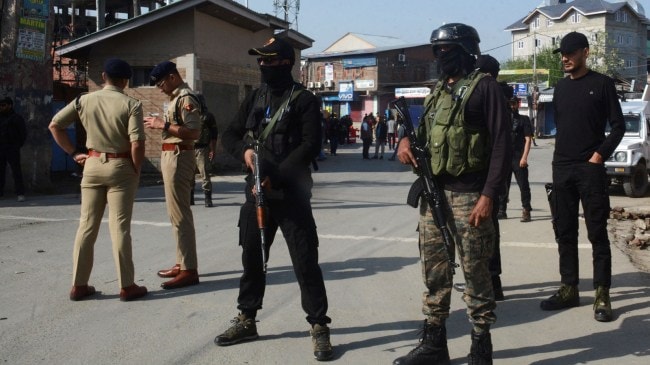Opinion Pahalgam attack: A comprehensive political solution is needed to defeat terror
There appears to be an attempt to internationalise the Kashmir issue, at a time when PM Modi was visiting Saudi Arabia, V-P Vance is in India, Pakistan is in throes of internal turmoil and economic freefall
 Police officers stand guard outside the police control room in Srinagar, following a militant attack near Pahalgam, April 23, 2025. (Photo: Reuters)
Police officers stand guard outside the police control room in Srinagar, following a militant attack near Pahalgam, April 23, 2025. (Photo: Reuters) On April 22, terrorists struck in Baisaran Valley, Pahalgam, in Jammu and Kashmir’s Anantnag district and reportedly killed 26 people and injured 10. The dead include officers of the Indian Navy and Intelligence Bureau, as well as foreigners. Reportedly, The Resistance Front (TRF), an affiliate of the banned, Pakistan-based Lashkar-e-Taiba, has claimed responsibility for the attack.
Baisaran, a popular tourist spot just north of Pahalgam, lies enroute to Chandanwari, the starting point of the lower route for the Sri Amarnath Ji Yatra (SAJY). On the southern side of Pahalgam is Anantnag, which has for long been a terrorist hotspot. This stretch, from Anantnag to Chandanwari, has witnessed terrorist activity and targeting of civilians. In August 2000, 32 persons were killed in a terror attack at Nunwan (a base camp for SAJY; located just south of Pahalgam). Another 13 pilgrims were killed in July 2001 at the Sheshnag camp, Anantnag. In 2002, terrorists struck the Chandanwari base camp, killing 11 persons, while seven were killed in July 2017 in Boatend (near Anantnag).
Prime Minister Narendra Modi and Union Home Minister Amit Shah have expressed resolve to continue combating terrorism, even as the latter rushed to Srinagar and security forces launched a massive hunt for the perpetrators of this cold-blooded massacre.
This appalling assault against civilians, the largest and most significant in many years, came when the US Vice President J D Vance was in India on an official visit; and it comes less than a week after Pakistan Army Chief General Asim Munir’s infamous “hard state” speech which included a reference to Kashmir; and two days after floods and landslides hit the Ramban-Dharmkund area and disrupted the vital Ramban Highway (directing focus towards search and rescue operations); and a few days after Tahawwur Rana was extradited to India.
Traditionally, terrorism has been a tactic of the weak; for those who lack the power to impose their will through ordinary political or military means. Thus, terrorism generally focuses on soft, civilian targets, rather than harder-to-attack military targets. Almost every successful major terror attack is aimed at sending a political message.
In this case, there appears to be an attempt to internationalise the Kashmir issue, at a time when PM Modi was visiting Saudi Arabia, Vance was in India, and most importantly, Pakistan is in the throes of internal turmoil and economic freefall. Finally, the attack could also be aimed at boosting local recruitment. Terrorist attacks usually have a psychological impact far outweighing the physical damage.
Kashmir is a rugged terrain, and terrorists often need local support to operate in a security grid. There are two widely differing thought processes on how to end local support within. One is an iron fist flattening anyone in its swing-path; the other is focused, intelligence-led operations combined with sagacious political solutions. A study by RAND on a large number of terrorist groups had found that 43 per cent were neutralised through a political process; 40 per cent through well-trained policing combined with intelligence services, 10 per cent because their goals were achieved; and in just 7 per cent of cases because of military force.
The security forces have repeatedly brought down terrorism to threshold levels. But each time, comprehensive, inclusive political solutions involving the local populace have eluded the region. As the RAND study suggests, a comprehensive political solution, in conjunction with acutely focused intelligence-led operations, with all stakeholders working in unison towards common objectives, is critical for ending local support and ensuring lasting peace.
The writer is a retired Brigadier from the Indian Army





